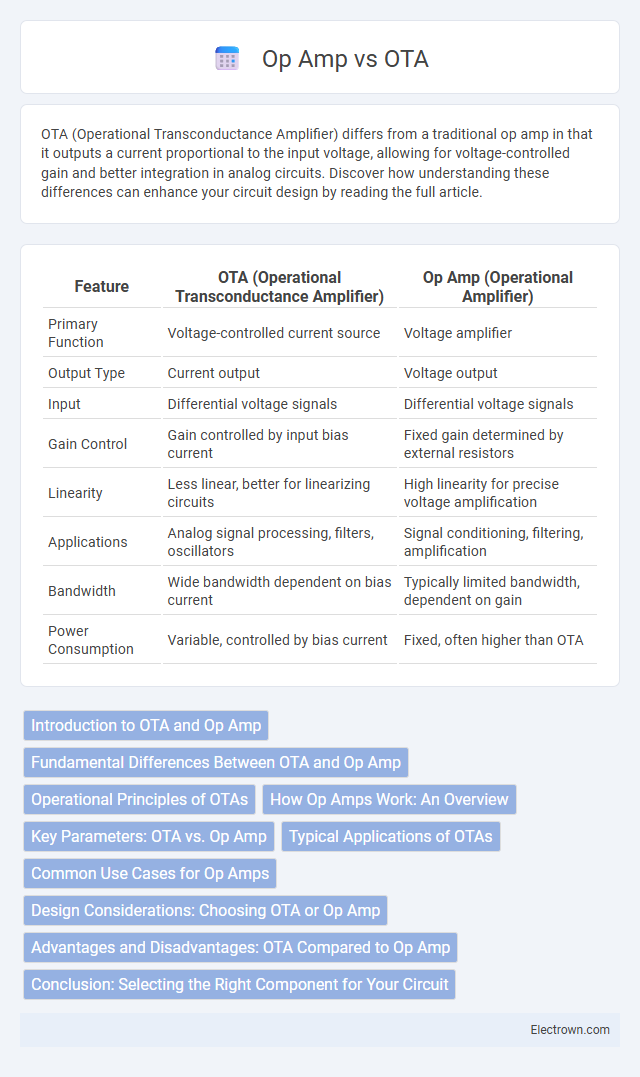OTA (Operational Transconductance Amplifier) differs from a traditional op amp in that it outputs a current proportional to the input voltage, allowing for voltage-controlled gain and better integration in analog circuits. Discover how understanding these differences can enhance your circuit design by reading the full article.
Table of Comparison
| Feature | OTA (Operational Transconductance Amplifier) | Op Amp (Operational Amplifier) |
|---|---|---|
| Primary Function | Voltage-controlled current source | Voltage amplifier |
| Output Type | Current output | Voltage output |
| Input | Differential voltage signals | Differential voltage signals |
| Gain Control | Gain controlled by input bias current | Fixed gain determined by external resistors |
| Linearity | Less linear, better for linearizing circuits | High linearity for precise voltage amplification |
| Applications | Analog signal processing, filters, oscillators | Signal conditioning, filtering, amplification |
| Bandwidth | Wide bandwidth dependent on bias current | Typically limited bandwidth, dependent on gain |
| Power Consumption | Variable, controlled by bias current | Fixed, often higher than OTA |
Introduction to OTA and Op Amp
Operational Transconductance Amplifiers (OTA) are voltage-controlled current sources that convert input voltage signals into proportional output currents, making them ideal for variable gain applications and analog signal processing. Operational Amplifiers (Op Amps) are voltage amplifiers with high gain and differential inputs, commonly used in signal conditioning, filtering, and mathematical operations in analog circuits. Both OTA and Op Amp play critical roles in electronics, but OTAs provide tunable gain based on bias current, while Op Amps offer fixed voltage gain with high input impedance.
Fundamental Differences Between OTA and Op Amp
Operational Transconductance Amplifiers (OTAs) differ fundamentally from operational amplifiers (op amps) in their input-output relationship; OTAs provide a variable transconductance output current proportional to the differential input voltage, while op amps deliver a voltage gain output. OTAs rely on bias current to control the transconductance, making them programmable and highly versatile in analog signal processing, unlike fixed-gain op amps. This intrinsic difference in architecture allows OTAs to be preferred in applications such as voltage-controlled amplifiers and filters, whereas op amps are commonly used for voltage amplification and buffering.
Operational Principles of OTAs
Operational Transconductance Amplifiers (OTAs) differ from traditional operational amplifiers (op amps) by converting input voltage signals into output currents, enabling variable gain control through a bias current. Unlike op amps, which provide voltage output, OTAs excel in applications requiring electronically tunable amplification, such as filters and oscillators. Your circuits benefit from OTA designs when precise gain modulation and high-frequency response are essential.
How Op Amps Work: An Overview
Op amps amplify the voltage difference between their inverting and non-inverting inputs using high-gain differential stages, producing a single-ended output. Internal stages include input differential pairs, gain stages, and a final output stage, enabling precise linear amplification with high input impedance and low output impedance. Your circuit benefits from op amps' versatility in filtering, buffering, and signal conditioning applications due to their predictable, stable gain characteristics.
Key Parameters: OTA vs. Op Amp
Operational Transconductance Amplifiers (OTAs) exhibit key parameters such as transconductance (gm), input bias current, and high gain bandwidth, distinguishing them from operational amplifiers (op amps) which prioritize voltage gain, input offset voltage, and slew rate. OTAs provide variable gain through bias current control, offering flexibility in analog signal processing, while op amps deliver fixed gain with stable voltage amplification. Noise performance and linearity also vary, with OTAs generally having higher input-referred noise and lower linearity compared to precision op amps, making each suitable for different application requirements.
Typical Applications of OTAs
Operational Transconductance Amplifiers (OTAs) are widely used in analog signal processing applications such as voltage-controlled amplifiers, filters, and oscillators due to their voltage-to-current conversion capabilities and high linearity. These devices excel in audio synthesis, modulation, and automatic gain control circuits where precise control of transconductance is essential. Your designs benefit from OTAs in applications requiring tunable gain and frequency response, distinguishing them from standard operational amplifiers optimized for voltage output.
Common Use Cases for Op Amps
Op amps are widely used in signal conditioning, such as amplification, filtering, and buffering, making them crucial for audio equipment, sensor interfaces, and analog computation. Their versatility enables precise voltage amplification in instrumentation, control systems, and communication devices. You benefit from op amps when precise linear amplification and low noise are essential in your electronic circuit designs.
Design Considerations: Choosing OTA or Op Amp
Design considerations for choosing between OTA and op amp depend on your application's requirements for linearity, gain bandwidth, and power consumption. OTAs offer tunable transconductance and are ideal for low-voltage, low-power designs with variable gain needs, while op amps provide fixed voltage gain, high linearity, and better output drive capabilities suitable for precision signal conditioning. Selecting the optimal device hinges on evaluating factors like input/output impedance, noise performance, and the specific analog signal processing functions you need.
Advantages and Disadvantages: OTA Compared to Op Amp
OTA (Operational Transconductance Amplifier) offers high input impedance and electronically tunable transconductance, making it ideal for voltage-controlled applications such as filters and oscillators. Unlike op amps, OTA's current output requires additional circuitry for voltage conversion, which can complicate designs and introduce noise. Your choice depends on the application; OTAs excel in adaptive and low-voltage systems, while op amps provide straightforward voltage amplification with simpler interfaces.
Conclusion: Selecting the Right Component for Your Circuit
Choosing between an OTA (Operational Transconductance Amplifier) and an op amp depends on your circuit's specific requirements such as linearity, gain control, and signal processing complexity. OTAs offer voltage-controlled transconductance ideal for adaptive filters and tunable oscillators, while op amps provide stable, high-gain voltage amplification suited for general-purpose applications. Your decision should consider the trade-offs in noise performance, linearity, and power consumption to achieve optimal circuit functionality.
OTA vs op amp Infographic

 electrown.com
electrown.com